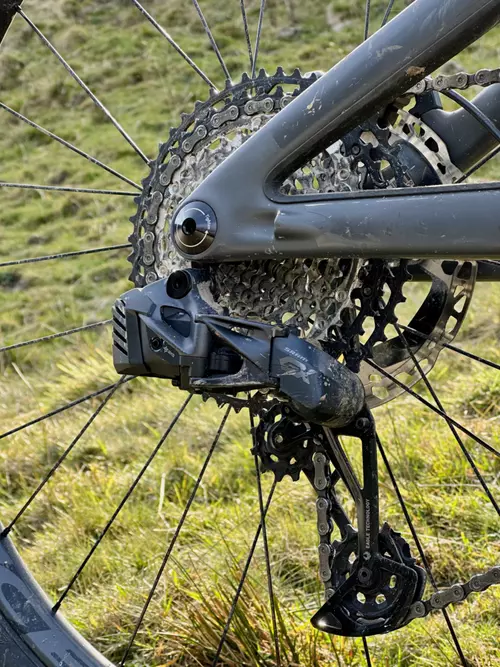
Setting up mountain bike suspension and optimize your mountain bike drivetrain.
The drivetrain is a critical component of a mountain bike. It is responsible for transferring power from the pedals to the rear wheel. Therefore this part is also important to adjust it right. First not only setting up mountain bike suspension right is an important aspect. A well-maintained drivetrain can improve the overall performance and efficiency of the bike. Therefore it’s important to keep it clean and properly adjusted. In this post, we’ll go over the main components of the mountain bike drivetrain. We will explain how to clean and lubricate it. Moreover we will provide tips on how to adjust and replace the chain and derailleurs.
Understanding the components of the mountain bike drivetrain
The main components of the mountain bike drivetrain include the chain, derailleurs, and cassette. The chain is a loop of links that connects the pedals to the rear wheel. Thus it is transferring the power from your legs to the bike. The derailleurs are responsible for shifting the chain between gears. This is allowing you to adjust your pedaling resistance to match the terrain. The cassette is a series of cogs that are attached to the rear wheel hub. It provides a range of gears for the chain to travel across.
Regular cleaning and lubrication of the mountain bike drivetrain is important to keep it running smoothly and extend its lifespan. By the way, this is also important when setting up mountain bike suspension. Here’s how to do it
- Shift the chain to the smallest cog and smallest chainring to make it easier to access.
- Use a chain cleaner tool or a cloth and degreaser to scrub the chain, working your way around the entire loop.
- Rinse the chain thoroughly with water to remove any remaining degreaser.
- Dry the chain with a clean cloth.
- Apply a thin layer of lubricant to the chain, making sure to cover all of the links.
- Shift the chain through all of the gears to distribute the lubricant evenly.
- Finally wipe off any excess lubricant with a clean cloth.
It’s important to use the correct type of lubricant for your chain. Further a dry lubricant is best for dry and dusty conditions, while a wet lubricant is better for wet and muddy conditions. Avoid using too much lubricant, as it can attract dirt and grime, leading to faster chain wear.
Adjusting the derailleurs is important
- Shift the chain to the smallest cog and smallest chainring.
- Equally important use the cable tension adjuster to ensure that the derailleur moves freely and returns to its original position when released.
- Shift the chain to the largest cog and largest chainring.
- Furthermore use the limit screws to adjust the position of the derailleur so that the chain is aligned with the cog and chainring.
- Finally shift the chain through all of the gears to test the shifting performance.
If the shifting is slow or hesitant, try tightening the cable tension. If the chain rubs against the derailleur or falls off the cog or chainring, try loosening the cable tension.
Replacing a bike chain
Further the chain is a wear item that will eventually need to be replaced, usually after about 1,500 miles of riding or when it starts to show signs of wear such as stretched links or bent rollers. Here’s how to replace a mountain bike chain:
- Shift the chain to the smallest cog and smallest chainring.
- Use a chain tool to push out one of the chain’s pins
- Slide the old chain off of the bike.
- Hold the new chain up to the old one to determine the correct length. The new chain should have the same number of links as the old one, or one more if you are using a half-link chain.
- Use the chain tool to push a pin into one end of the new chain.
- Thread the chain through the derailleurs and around the cassette.
- Use the chain tool to push the other end of the chain together, forming a loop.
- Use the chain tool to push the second pin into the chain, completing the loop.
- Shift the chain through all of the gears to test the shifting performance.
Again it’s important to use a chain tool specifically designed for the type of chain you are using. Some chains require special pins that can only be inserted with a compatible chain tool.
In conclusion
Maintaining and optimizing your mountain bike drivetrain is an important part of keeping your bike running smoothly and efficiently. Besides by cleaning and lubricating the chain and derailleurs, and adjusting and replacing them as needed, you can help ensure that your drivetrain is always performing at its best. In this way don’t neglect this critical component of your bike – give it the care it deserves and you’ll be rewarded with a better riding experience. Lastly of course setting up mountain bike suspension is an important task as well, when you want to improve your riding and expanding your mountain bikes lifespan. Exactly for this reason exists SAGLY. You can document, tune and compare your mountain bike settings with SAGLY. Download it for free.
Download SAGLY, a complete mobile guide for your mountain bike riding, suspension settings and maintenance.

